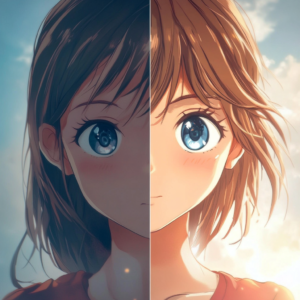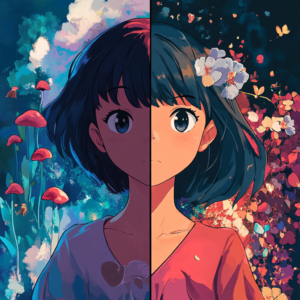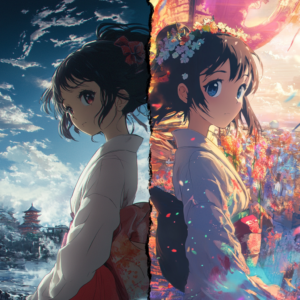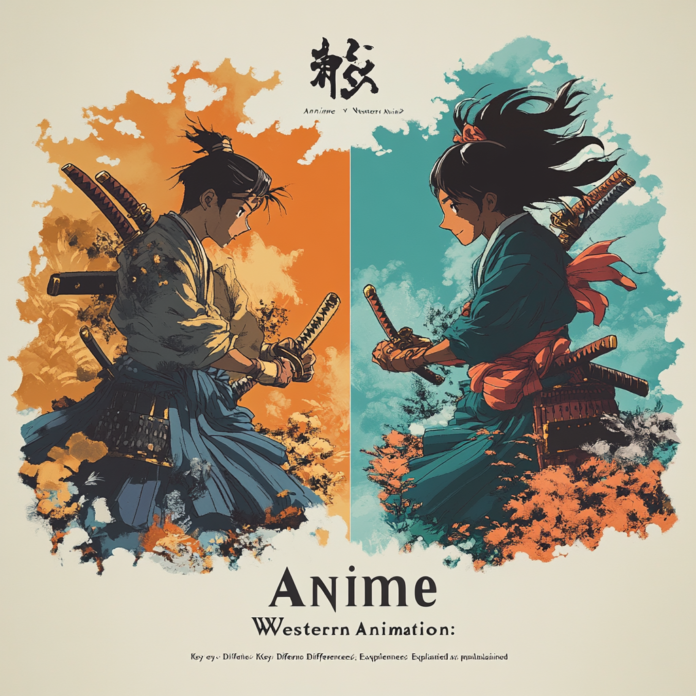1. Introduction
Animation has long been a beloved medium around the world, but two distinct styles have evolved over the decades: anime, with its rich cultural roots in Japan, and Western animation, characterized by its diverse stylistic approaches in the United States and Europe. In this guide, Anime vs. Western Animation: Key Differences Explained, we examine the core differences that define these two traditions. Our focus keyword, Anime vs. Western Animation, will serve as the foundation for our exploration as we discuss historical backgrounds, artistic techniques, narrative structures, cultural influences, and production processes. Understanding Anime vs. Western Animation not only enhances your appreciation for the art form but also helps you recognize the unique strengths of each style. Whether you’re a long-time fan or new to animation, this article provides comprehensive insights into how these distinct traditions have evolved and how they continue to shape global entertainment. For more on animation trends, check out Breaking Down the Latest Anime Movie Plot Twists and explore discussions on Exploring Anime Fandom: Trends, Theories and More.

2. Historical Background and Evolution
The evolution of Anime vs. Western Animation is steeped in history, with each tradition emerging from distinct cultural and technological contexts.
2.1. The Origins of Anime
Anime, rooted in Japan’s rich artistic and cinematic traditions, began as a form of experimental storytelling in the early 20th century. Early Japanese animation drew inspiration from traditional art forms such as ukiyo-e and kabuki theater, which are evident in its stylized character designs and narrative themes that emphasize honor, duty, and emotional depth. With limited resources, early anime relied on hand-drawn cel animation, resulting in a distinctive aesthetic characterized by bold lines and expressive features. Over time, as techniques evolved, serialized narratives and complex character-driven plots emerged, setting the stage for globally acclaimed franchises.
2.2. The Emergence of Western Animation
In contrast, Western animation developed along a trajectory influenced by theatrical traditions and advances in film technology. During Hollywood’s Golden Age, studios like Disney, Warner Bros., and MGM revolutionized the medium with both short, comedic pieces and feature-length films that prioritized whimsy, heart, and technical brilliance. The advent of color film and synchronized sound set new standards for storytelling and visual innovation. In subsequent decades, Western animation diversified its approach, embracing both family-friendly content and more mature, sophisticated narratives, as seen in films like Spider-Man: Into the Spider-Verse.
3. Artistic Styles and Techniques
The visual language of Anime vs. Western Animation is one of the most evident points of difference between the two.
3.1. Anime Artistic Characteristics
Anime is recognized for its distinctive visual style, featuring large, expressive eyes, detailed hairstyles, and dynamic character designs that emphasize emotional depth. Richly detailed backgrounds and symbolic use of color further define its aesthetic, drawing on traditional Japanese art and modern digital techniques.
3.2. Western Animation Styles
Western animation, meanwhile, exhibits a broad spectrum of styles—from highly realistic CGI to exaggerated cartoonish forms. It typically emphasizes clear, linear storytelling, and employs diverse techniques tailored to different genres, whether in theatrical blockbusters or classic television cartoons.
3.3. Comparative Analysis
While both traditions share the medium of animation, anime often focuses on emotional expression and layered symbolism, whereas Western animation tends to prioritize clarity, humor, and broad appeal. This contrast highlights the unique cultural imprints and technical approaches that define each style.
4. Narrative and Storytelling Approaches
Beyond visual aesthetics, Anime vs. Western Animation diverges significantly in narrative structure and storytelling techniques.
4.1. Anime Storytelling
Anime is renowned for its complex, serialized narratives that delve deep into character development and thematic exploration. It often weaves intricate plots that incorporate symbolism, metaphor, and genre-blending elements, encouraging long-term viewer investment.
4.2. Western Animation Storytelling
Western animation frequently opts for self-contained, episodic narratives with a strong emphasis on humor, character-driven plots, and moral lessons. However, contemporary trends are seeing an increase in serialized formats that address more mature themes.
4.3. Comparative Narrative Analysis
The differences in narrative style result in distinct viewing experiences: anime’s layered and intricate plots contrast with the straightforward, often lighthearted storytelling of Western animation. These approaches reflect the cultural contexts from which they emerged and continue to evolve.
5. Cultural Influences and Themes
Culture is a fundamental factor in shaping both anime and Western animation, and examining these influences reveals key differences in their thematic approaches.
5.1. Cultural Roots of Anime
Anime is deeply intertwined with Japanese history, literature, and social norms. Its storytelling frequently incorporates traditional values, folklore, and philosophical themes, resulting in narratives that are both symbolic and emotionally resonant.
5.2. Cultural Roots of Western Animation
Western animation reflects a blend of diverse cultural influences, emphasizing individualism, innovation, and often a humorous or satirical perspective. It draws from a wide range of artistic traditions, making it eclectic in style and approach.
5.3. Comparative Cultural Analysis
The cultural influences result in distinct thematic focuses: anime often explores collective and philosophical themes, while Western animation emphasizes personal growth and broad, accessible humor. For further cultural insights, visit Anime News Network and Rotten Tomatoes.
6. Production Techniques and Technological Innovations
The production processes behind Anime vs. Western Animation showcase a variety of methodologies and technological advancements.
6.1. Production in Anime
Anime traditionally relies on hand-drawn techniques, gradually incorporating digital tools such as CGI and compositing to enhance visual detail and fluidity. Despite working with often tighter budgets and schedules, anime studios have developed innovative methods to deliver compelling narratives.
6.2. Production in Western Animation
Western animation benefits from larger production budgets and extensive use of advanced CGI and 3D modeling. This enables highly realistic and visually immersive productions that push the boundaries of animated storytelling.
6.3. Comparative Production Analysis
While anime maintains a handcrafted aesthetic with expressive detail, Western animation leans heavily on technological innovation and realism. These differing approaches not only influence the final product but also reflect the distinct cultural and economic environments in which they are produced. For more on production techniques, check out Animation World Network.
7. Audience, Market, and Distribution Differences
The consumption and distribution of Anime vs. Western Animation vary significantly due to differences in audience demographics and market strategies.
7.1. Audience Demographics
Anime caters to a wide range of age groups, often engaging viewers through serialized narratives and complex character arcs. In contrast, Western animation traditionally targets family audiences, though recent trends have expanded its demographic reach to include more mature themes.
7.2. Market Distribution
Anime has evolved from traditional television networks and DVD releases to a dominant presence on streaming platforms like Crunchyroll and Netflix. Western animation enjoys widespread global distribution through theaters, television, and digital platforms, benefiting from robust marketing strategies.
7.3. Economic Impact
Economic models also differ: anime relies on a mix of domestic and international revenue streams, while Western animation often benefits from higher production budgets and extensive merchandising. For further economic insights, visit Statista.
8. Case Studies: Iconic Examples from Both Worlds
Comparing iconic works from both traditions offers a clearer picture of Anime vs. Western Animation.
8.1. Case Study: Anime – “Attack on Titan”
Attack on Titan exemplifies anime’s ability to merge intense, gritty action with profound narrative complexity. Its battle scenes, steeped in historical and cultural symbolism, reflect themes of sacrifice, honor, and the human struggle against overwhelming odds.
8.2. Case Study: Western Animation – “Spider-Man: Into the Spider-Verse”
This film represents the pinnacle of Western animation innovation. With groundbreaking CGI, a dynamic comic book aesthetic, and a focus on diverse, character-driven storytelling, it has redefined animated action for a global audience.

9. Impact on Global Entertainment and Fan Communities
The influence of Anime vs. Western Animation extends far beyond the screen, shaping global entertainment and fan culture.
- Global Cultural Impact: Both forms have carved significant cultural niches worldwide, influencing global media and inspiring diverse creative endeavors.
- Fan Engagement: Robust fan communities, online forums, and social media platforms foster vibrant discussions, cosplay, and fan art, enriching the cultural legacy of both traditions.
- Merchandising and Branding: Iconic animated works drive extensive merchandising, contributing to both economic impact and cultural significance.
- Cross-Media Influence: The innovations and narrative techniques in anime and Western animation often influence other media, including live-action films, video games, and even academic research.
For more on global trends in animation, visit Crunchyroll News.
10. Future Trends in Animation
Looking ahead, the future of Anime vs. Western Animation will be shaped by emerging technologies and evolving storytelling techniques.
- Hybrid Animation Techniques: Both traditions are increasingly blending hand-drawn art with advanced digital CGI to create richer, more dynamic visual experiences.
- Interactive and Immersive Viewing: Innovations in augmented reality (AR) and virtual reality (VR) promise to blur the lines between viewer and participant, creating immersive storytelling experiences.
- AI and Automation: The integration of AI in animation production will streamline workflows and enhance the quality of visual effects.
- Narrative Evolution: As global audiences demand more complex stories, both anime and Western animation are likely to explore deeper, more layered narratives that resonate on a universal level.
For a visual demonstration of emerging animation trends, watch this YouTube video on digital animation innovations.
11. Frequently Asked Questions
Q1: What are the main differences between anime and western animation?
A1: Anime typically features intricate, serialized narratives and distinctive artistic styles deeply rooted in Japanese culture, while western animation often emphasizes humor, clear storytelling, and a diverse range of visual techniques.
Q2: How do production techniques differ between the two?
A2: Anime relies on a blend of traditional hand-drawn techniques and digital enhancements, whereas western animation frequently employs advanced CGI and 3D modeling for a more realistic visual experience.
Q3: What cultural influences shape each style?
A3: Anime draws heavily from Japanese history, folklore, and philosophical traditions, while western animation reflects a melting pot of cultural influences with an emphasis on individualism and innovation.
Q4: How has globalization affected both anime and western animation?
A4: Globalization has led to increased cross-cultural collaboration, blending narrative and artistic elements from both traditions, though each maintains its distinct cultural identity.
Q5: What strategies can fans use to stay informed about animation trends?
A5: Fans should follow official channels, use reliable news sources, set up alerts, cross-reference information, and engage in community discussions to ensure they learn Anime vs. Western Animation differences accurately.
12. Call to Action & Affiliate Offers
If you’re interested in diving deeper into other topics, I recommend checking out this comprehensive guide that walks you through each step with video tutorials, downloadable resources, and expert insights. Check it here.
Your support is crucial in helping us continue delivering high-quality content that informs, inspires, and empowers you to understand Anime vs. Western Animation differences.
13. Exclusive Visual Showcase
To visually complement this guide, here is an exclusive image created specifically for this article, capturing the essence of the stylistic and narrative contrasts between anime and western animation.

14. Conclusion
Through this guide, we have undertaken a comprehensive examination of two rich animation traditions—anime and Western animation—highlighting both their distinctive qualities and the ways in which they intersect and influence one another.
Historical Evolution
We traced anime’s origins from early 20th-century experimental shorts in Japan to its rise as a global cultural phenomenon, alongside the parallel development of Western animation from Winsor McCay’s pioneering work to today’s blockbuster studio features. This historical perspective underscores how each tradition has been shaped by its cultural context and technological milestones.Artistic Styles and Visual Language
Anime is characterized by expressive character designs, striking use of color, and cinematographic framing that often evokes manga panels brought to life. In contrast, Western animation tends toward fluid, rubber-hose movement, clear visual storytelling, and broad stylistic diversity—from the stylized minimalism of UPA to the hyper-realism of current CGI.Narrative Approaches and Thematic Depth
While anime frequently explores complex, serialized storylines and mature themes—ranging from existential philosophy to social critique—many Western productions emphasize tightly structured, episodic plots with a strong focus on humor, adventure, and universal moral lessons. Both, however, are increasingly borrowing elements from one another, resulting in hybrid narratives that blend introspection with broad appeal.Production Techniques and Workflow
From traditional cel animation and hand-painted backgrounds to today’s digital pipelines and production committees, we contrasted the studio systems in Japan and the West. Each model reflects different priorities—efficient long-form output in anime versus high-budget tentpole features in the West—yet both have embraced digital tools to streamline tasks and expand creative possibilities.Global Impact and Cross-Pollination
Finally, we examined how anime’s success abroad has inspired Western creators (seen in series like Avatar: The Last Airbender), and how major Japanese studios now collaborate with Western partners. This ongoing exchange enriches the medium worldwide, fostering innovative styles and narratives that defy simple categorization.
By understanding these key differences and synergies, you can deepen your appreciation for animated storytelling in all its forms. I encourage you to revisit your favorite titles—whether a classic anime saga or a Western animated masterpiece—with fresh eyes, join fan and scholarly discussions, and continue exploring this ever-evolving art form with both curiosity and critical insight.
